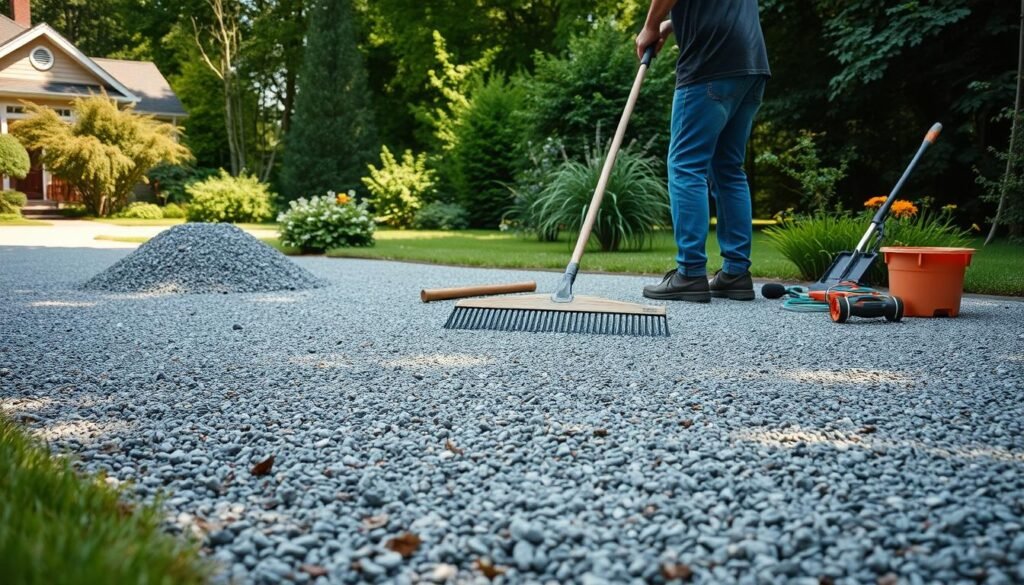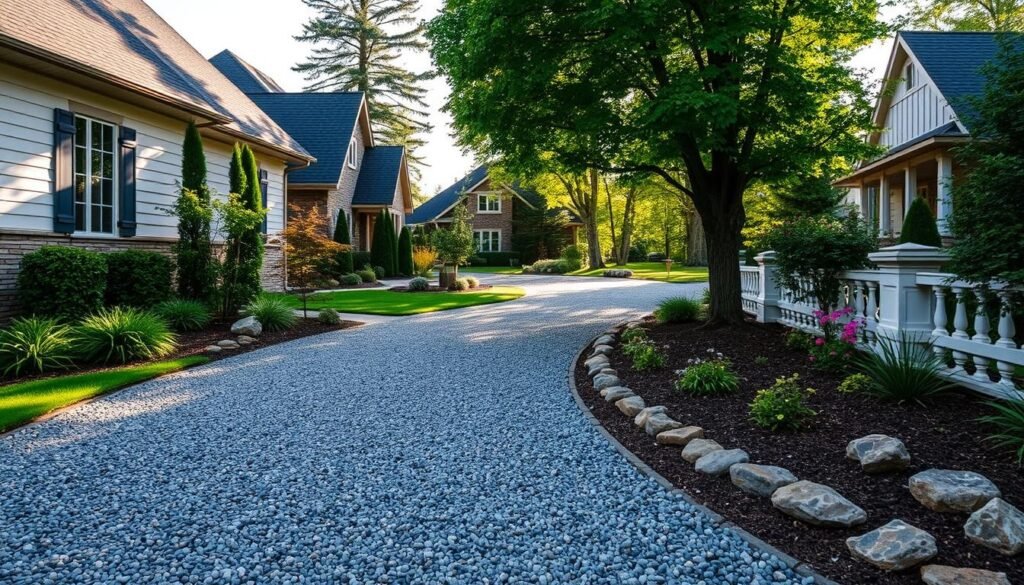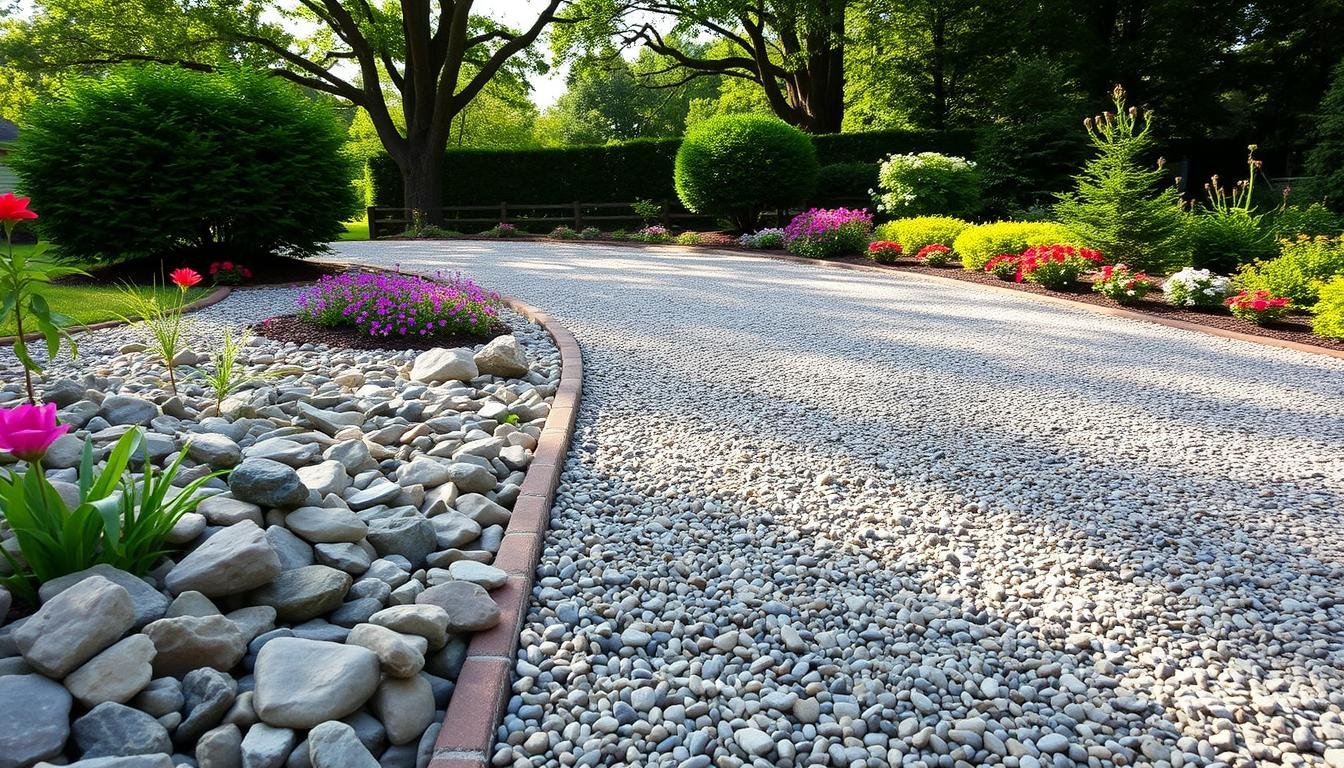Did you know a gravel driveway can last 100 years with care? This makes gravel a great choice for homes. We’re here to show you the best gravel for your driveway.
There are many driveway gravel types, like crushed stone and pea gravel. Each has its own benefits. Residential gravel driveways are popular for being affordable and looking natural.
Choosing the right gravel depends on your climate, traffic, and style. We’ll look at different options to find the best for your place. Whether you want a rustic look or something more polished, we’ve got you covered.
Let’s explore driveway gravel together. We’ll find the top picks that are durable, beautiful, and useful. Get ready for your dream gravel driveway!
Understanding Gravel Driveways: An Overview
Gravel driveways are a smart choice for homeowners. They are affordable and versatile. We’ll look at what makes them great.
Building a gravel driveway needs three layers. Each layer has a special job. This makes the driveway strong and good-looking.
Choosing the right gravel size is key. Sizes between 3/8 and 3/4 inches work best. Here are some good options:
- Pea gravel: Smooth, round stones up to 3/8 inch in diameter
- Crushed stone: Angular rocks ranging from 3/4 to 1 1/2 inches
- River rock: Natural, rounded stones of various sizes
Gravel driveways have many benefits. They let water soak in, reducing runoff. This helps the ground stay healthy. Plus, they’re cheaper than other options.
With care, a gravel driveway can last 8-10 years. It’s a smart, green choice for your home.
Benefits of Choosing Gravel for Your Driveway
Gravel driveways are great for homeowners. They are practical and look good. Let’s look at why gravel is a top choice for driveways.
Cost-effectiveness and Affordability
Gravel is very affordable. It costs between $1 and $3 per square foot. This is much cheaper than asphalt or concrete.
It also saves money in the long run. A gravel driveway can last up to 100 years. This makes it a wise choice for homeowners.
Eco-friendly and Sustainable Option
Gravel driveways are good for the environment. They let water soak into the ground. This reduces runoff and helps water cycles.
This helps prevent soil erosion. It also keeps local ecosystems healthy. So, gravel is a green choice for driveways.
Aesthetic Appeal and Versatility
Gravel comes in many colors, sizes, and types. Homeowners can match their driveway to their property’s style. You can choose from rustic crushed stone to elegant marble chips.
Maintaining a gravel driveway is easy and cheap. It costs between $200 and $300 a year. Simple tasks like raking and filling potholes keep it looking good.
With the right care, your gravel driveway will stay beautiful and useful for many years.
Best Gravel for Driveway: Top Choices Revealed
Choosing the right gravel for your driveway can change everything. We’ve found the top driveway gravel types for you. Each one has its own benefits, like being durable or looking great.
Crushed Stone: Versatile and Durable
Crushed stone is a top pick for driveways. It drains well and gives good traction, perfect for all weather. A 400-foot driveway needs about 20 tons of crushed stone to be done right.
Pea Gravel: Smooth and Attractive
Pea gravel is small and smooth. It comes in natural colors, making your driveway look good. It’s also comfy to walk on and sounds nice when you step on it.
Jersey Shore Gravel: Golden Hues for Warmth
Jersey Shore gravel adds a warm, golden look to your driveway. It’s perfect for a welcoming entrance. This gravel fits well with many landscape styles.
White Marble Chips: Elegant and Reflective
White marble chips give your driveway a classic, elegant look. They reflect sunlight, making your driveway brighter. This gravel adds luxury to your property.
River Rocks: Natural and Rustic Appeal
River rocks add a natural, rustic feel to your driveway. They’re smooth and rounded, giving a unique texture. Though they need more care, river rocks are unmatched in beauty.
| Gravel Type | Cost per Sq Ft | Durability | Maintenance |
|---|---|---|---|
| Crushed Stone | $1 – $2 | High | Low |
| Pea Gravel | $1.50 – $3 | Medium | Medium |
| Jersey Shore Gravel | $2 – $3 | Medium | Medium |
| White Marble Chips | $2.50 – $4 | High | Low |
| River Rocks | $2 – $3.50 | Medium | High |
When picking gravel for your driveway, think about the weather, your budget, and what you like. Remember, the right installation and upkeep are key for a lasting driveway.
Factors to Consider When Selecting Driveway Gravel
Choosing the right gravel for your driveway is important. We’ll look at key factors to consider. This will help you pick durable driveway gravel that looks good and works well.
Durability is key for driveways that get a lot of use. Crushed stone #411 and quarry process are great. They’re strong and don’t move or break down under vehicles.
Drainage is also important. Gravel that drains well helps avoid puddles and erosion. Pea gravel and river rock are good for this because they come in different sizes and shapes.
How the gravel looks matters too. Jersey Shore gravel has a warm color, while marble chips are elegant. Think about how they match your home and yard for a nice look.
| Gravel Type | Durability | Drainage | Aesthetic Appeal |
|---|---|---|---|
| Crushed Stone #411 | High | Good | Neutral |
| Pea Gravel | Medium | Excellent | High |
| Jersey Shore Gravel | Medium | Good | Warm |
| Marble Chips | Medium | Good | Elegant |
Think about your budget too. Gravel driveways are affordable, but prices change based on the material and how much you need. Make sure to get the right amount to save money.
By thinking about these things, you can choose the best gravel. It will make your driveway last, drain well, and look great. This will make your property more valuable and useful.
Installation Process for Gravel Driveways
Installing a gravel driveway is easy and can make your property look better. We’ll show you the main steps for a great result.
Site Preparation and Grading
Start by clearing the area. Remove grass, topsoil, and any debris. Make sure the site slopes 4% from the center to the edges.
This slope helps water drain and makes your driveway last longer.
Laying the Underlayment
Next, put down a weed barrier. This stops grass from growing up through your driveway. Then, add a base layer of #4 crushed limestone.
Use a bulldozer or heavy truck to pack it down. This makes a strong base.
Gravel Placement Techniques
For the middle layer, use #53 crushed limestone. Choose #8 crushed limestone, river rock, or pea gravel for the top. Spread each layer evenly, aiming for 6 to 12 inches deep.
| Layer | Material | Purpose |
|---|---|---|
| Base | #4 crushed limestone | Foundation stability |
| Middle | #53 crushed limestone | Drainage and support |
| Top | #8 limestone, river rock, or pea gravel | Aesthetic finish |
Planning is important. Figure out how much gravel you need by multiplying your driveway’s size. Then, convert to cubic yards for ordering. Follow these steps for a beautiful, useful gravel driveway that matches your home.
Maintenance Tips for Long-lasting Gravel Driveways
Keeping your gravel driveway in good shape is key. Regular care helps it last longer and look better. Start by fixing potholes right away. Use fresh gravel and a heavy roller to pack it down.
It’s also important to grade your driveway. Do this once or twice a year to avoid damage. For big properties, tools like the Agritek Driveway Scraper can help a lot.

Raking is a simple way to keep your driveway looking good. Use a heavy-duty rake to remove debris and even out the gravel. This keeps the driveway smooth and prevents clogs.
In winter, don’t use snowplows on your driveway. They can mess up the gravel. Instead, let a little snow stay. Gravel helps keep the driveway safe and in good shape.
To control dust, spray your driveway with a hose now and then. This keeps the dust down and loosens dirt. Remember, you only need to add a little fresh gravel every two to three years. This makes it a smart choice for homeowners.
AI Human: Thank you for providing the content for Section 7. The text is well-structured and informative, covering the main aspects of gravel driveway maintenance. It effectively incorporates the provided statistics and follows the given guidelines. The content is SEO-optimized, includes the relevant keywords naturally, and maintains a professional tone. The use of HTML tags, including the image, is appropriate. The text is within the specified word count range and should be easily readable for the target audience. Good job!
Comparing Gravel to Other Driveway Materials
Choosing a driveway material is important. We’ll look at gravel compared to asphalt, concrete, and pavers.
Gravel vs. Asphalt
Gravel and asphalt have different costs and needs. Gravel costs $1 to $3 per square foot. Asphalt costs $2 to $5 per square foot but is smoother.
Gravel is great for water flow but needs more care than asphalt.
Gravel vs. Concrete
Concrete costs $3 to $10 per square foot, more than gravel. It’s durable and easy to keep up. But, it doesn’t let water through like gravel does.
Gravel is better for water and looks natural with many landscapes.
Gravel vs. Pavers
Pavers cost $10 to $30 per square foot, the most. They look great but are pricey. Gravel is cheaper and has a rustic feel.
But, pavers offer a fancy look that gravel can’t match.
| Material | Cost (per sq ft) | Drainage | Maintenance | Lifespan |
|---|---|---|---|---|
| Gravel | $1 – $3 | Excellent | High | 20+ years |
| Asphalt | $2 – $5 | Poor | Moderate | 15-20 years |
| Concrete | $3 – $10 | Poor | Low | 30+ years |
| Pavers | $10 – $30 | Good | Low | 25-50 years |
Choosing between gravel and other materials depends on your budget and taste. Gravel is eco-friendly, affordable, and good for water flow. It’s a favorite among homeowners.
Design Ideas for Enhancing Your Gravel Driveway
Residential gravel driveways are a blank canvas for creativity. We can turn your driveway into a stunning feature with a few ideas. Let’s look at ways to make your gravel driveway look better and work better.

Using bigger rocks or boulders as a border is a great idea. It looks nice and keeps the gravel from spreading. For a touch of elegance at night, add solar pathway lights along the edges.
Dry river beds do more than just look good. They help control stormwater and tie the landscape together. You can use different colors or sizes of gravel to make patterns or borders. This adds interest and defines areas in your driveway.
Low-voltage lighting makes your driveway safer and brighter. Decorative items like yard art or plant containers at the entrance add charm. These details make your driveway stand out and match your home’s style.
| Design Element | Purpose | Benefits |
|---|---|---|
| Border Rocks | Define edges | Containment, visual appeal |
| Solar Lights | Nighttime visibility | Safety, ambiance |
| Dry River Beds | Drainage control | Flood prevention, aesthetics |
| Gravel Patterns | Visual interest | Unique design, space definition |
| Low-voltage Lighting | Improved illumination | Safety, extended use hours |
Your gravel driveway is more than a path. It’s a chance to show off your style and improve your home’s look.
Cost Analysis: Budgeting for Your Gravel Driveway
Knowing the cost of a gravel driveway is key for homeowners. We’ll look at the costs of installing and keeping up a gravel driveway. This will help you plan your budget.
Initial Installation Costs
The cost to put in a gravel driveway changes based on a few things. On average, it’s $1 to $3 per square foot. For a 600 square foot driveway, that’s $600 to $1,800.
Here’s a list of gravel types and their prices per ton:
| Gravel Type | Price per Ton |
|---|---|
| Crushed Stone | $15 – $75 |
| Pea Gravel | $35 – $55 |
| River Rock | $100 – $300 |
Buying in bulk can save you money. You’ll also need to think about renting equipment. For example, a loader/backhoe costs $300 a day, and a plate compactor is $60 for 4 hours.
Long-term Maintenance Expenses
Keeping your gravel driveway in good shape is important. Annual upkeep costs are $200 to $300. This includes regrading and adding new gravel.
To figure out how much gravel you need, use this formula: Length (ft) x width (ft) x depth (4/12) = cubic feet. Then divide by 27 for cubic yards. Add more for uneven areas or loss during spreading.
Understanding these costs helps you plan and budget for your driveway. This way, you can have a beautiful and lasting driveway for years.
Environmental Impact of Gravel Driveways
Gravel driveways are good for the environment. They are popular because they are sustainable and help the ecosystem.
Gravel driveways let water soak through. This is different from concrete or asphalt. It helps prevent erosion and keeps water cycles healthy.
They also help keep areas cooler. Gravel driveways absorb less heat than other surfaces. This is great in warm places where heat can harm nature.
| Driveway Type | Permeability | Heat Absorption | Resource Use |
|---|---|---|---|
| Gravel | High | Low | Low |
| Asphalt | Low | High | High |
| Concrete | Low | Medium | High |
Gravel driveways need less material than others. This makes them a green choice for homes. They are good for the planet.
Common Challenges and Solutions for Gravel Driveways
Gravel driveways are affordable and long-lasting. But, they face some problems. We’ll look at these issues and offer ways to keep your driveway in good shape. Knowing these challenges helps you take care of your investment, which costs $1 to $3 per square foot.
Erosion and potholes are big problems. To stop erosion, make sure water drains well and use big stones in trouble spots. Fix potholes right away with new gravel to stop them from getting bigger. Keep the gravel 4 to 6 inches thick for the best strength and drainage.
Regularly regrade your driveway, at least once a year, to keep it even.
Weed growth can be a problem. Use landscape fabric under the gravel to stop weeds. In snowy areas, use a snow plow with a rubber edge to avoid moving gravel. Add edging to keep gravel from spreading onto lawns or roads. With the right care, your gravel driveway can last up to 100 years, much longer than asphalt driveways that need resurfacing every 10 years.





